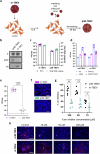Irreversible furin cleavage site exposure renders immature tick-borne flaviviruses fully infectious
- PMID: 40796726
- PMCID: PMC12343913
- DOI: 10.1038/s41467-025-62750-6
Irreversible furin cleavage site exposure renders immature tick-borne flaviviruses fully infectious
Abstract
Flavivirus assembly is driven by the envelope glycoproteins pre-membrane (prM) and envelope (E) in the neutral pH environment of the endoplasmic reticulum. Newly budded, spiky particles are exported through the Golgi apparatus, where mildly acidic pH induces a major surface rearrangement. The glycoproteins reorganize into (prM/E)\₂ complexes at the surface of smooth particles, with prM trapped at the E dimer interface, thereby exposing a furin cleavage site (FCS) for proteolytic maturation into infectious virions. Here, we show that in the absence of furin, immature tick-borne flavivirus particles-tick-borne encephalitis virus, Langat virus, and Louping ill virus-remain fully infectious and pathogenic in female BALB/c mice, in contrast to mosquito-borne flaviviruses such as Usutu, West Nile, and Zika viruses. We further show that the FCS in tick-borne viruses remains exposed at neutral pH, allowing furin at the surface of target cells to activate viral fusogenicity, while mosquito-borne counterparts require acidic re-exposure. Mutations increasing the dynamic behavior of the E dimer mimic the mosquito-borne phenotype, with retracted FCS at neutral pH and loss of infectivity. Our multidisciplinary approach-combining virological assays, targeted mutagenesis, structural modeling, and molecular dynamics simulations-highlights the role of E dimer dynamics in regulating flavivirus maturation and infectivity.
© 2025. The Author(s).
Conflict of interest statement
Competing interests: The authors declare no competing interests.
Figures






References
-
- Gould, E. & Solomon, T. Pathogenic flaviviruses. Lancet371, 500–509 (2008). - PubMed
-
- Chiffi, G., Grandgirard, D., Leib, S. L., Chrdle, A. & Ruzek, D. Tick-borne encephalitis: a comprehensive review of the epidemiology, virology, and clinical picture. Rev. Med. Virol.33, e2470 (2023). - PubMed
-
- Campbell, G. L., Marfin, A. A., Lanciotti, R. S. & Gubler, D. J. West Nile virus. Lancet Infect. Dis.2, 519–529 (2002). - PubMed
-
- Solomon, T. & Vaughn, D. W. Pathogenesis and clinical features of Japanese encephalitis and West Nile virus infections. Jpn. Encephalitis West Nile Viruses267, 171–194 (2002). - PubMed
MeSH terms
Substances
Grants and funding
LinkOut - more resources
Full Text Sources
Other Literature Sources

